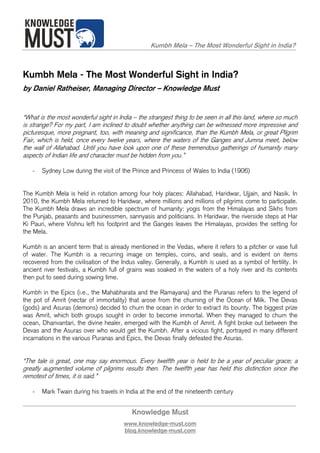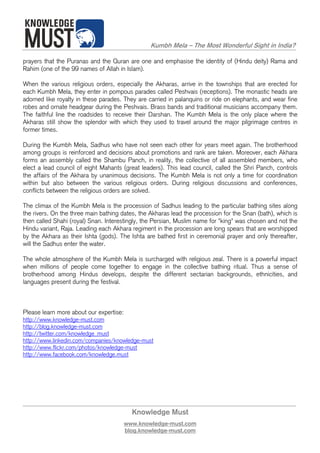The Kumbh Mela is one of the largest religious gatherings in the world, held every 12 years in India where the Ganges and Yamuna rivers meet. Millions of Hindu pilgrims attend to ritually bathe, seeking to cleanse themselves of sins and attain moksha. The festival is a vibrant display of religious worship, cultural traditions, and a sense of Hindu spiritual brotherhood. Various ascetic orders and sects that are usually separate come together in a spectacular fashion to reinforce their bonds and coordinate activities.

![Kumbh Mela – The Most Wonderful Sight in India?
Pilgrimage to sacred places is a very ancient practice found almost universally across the world’s religions.
But pilgrimage also has an inner path next to the outer path of journeying to a sacred place. Pilgrimage
includes the internal voyage to one’s own religion. In the beginning, the performance of Yajnya (sacrificial
ritual) was dominating in Hindu religions. Over time, the resource-intensiveness of sacrifices and the
exclusion of large parts of the population from performing Yajnya led to the development of substitutes.
One expression of this development is the institution of pilgrimage.
Places of pilgrimage in India are referred to as Tirthas, which is derived from the Sanskrit verb “Tr”,
meaning to cross. The term Tirtha occurs eight times in the Rig Vega, all of them associating it with
water. In time, the term Tirtha was used more and more exclusively for river banks or confluences of
rivers sanctified by the performance of sacrifices and the revelation of mantras.
The formation of Hindu places of pilgrimage was largely shaped through important ritual sacrifices that
were performed at a specific location. Because these places were generally next to sources of water
(rivers, lakes and the sea), they became the major locations of pilgrimage centres, and remain so today
(e.g., Puri, Gaya, Haridwar, and Varanasi). The prominence of water is derived from its many qualities:
water is frequently used in sacrifices, is the primeval source of creation, symbolises the flow of life, and is
required for purification rituals.
The Bengali poet Rabindranath Tagore offers a similar rationale behind the locations of Indian pilgrimage
places: “India chose her places of pilgrimage where there was in nature some special grandeur or beauty,
so that her mind could come out of its world of narrow necessities and realize its place in the infinite.”
Further, Tirthayatra (pilgrimage) offers the opportunity to leave the historically and socially structured time
of one’s day-to-day life and enter the sacred mythological time of the gods. Even untouchables and
widows, who otherwise are generally excluded from most religious rituals, can participate, thus allowing
them to break out of the rigid structures of their local communities. At Tirthas, a sacred re-enactment of
myths takes place according to the religious beliefs of Hindus. Pilgrims walk on the same ground on
which deities and the heroes of the Epics strolled. A whole cosmic event recurs with the pilgrims as
participants.
“Although Hinduism does not make pilgrimage obligatory, yet the ordinary Hindu attribute great
importance to tirth-yatra where they resort to a host of merit-earning activities like taking a holy dip,
darshan (respectful sight of devotion and surrender) of deities, temples, and ascetics, performing worship,
listening to religious discourses, hymns and devotional songs in praise of deity, doing charity to Brahman,
beggar and ascetics – all these believed [are] believed to earn punya for an individual thereby advancing
him to the ultimate goal of moksh.” ("The Tradition of Kumbh", Das and Singh, 1990)
“The Fair (…) is run by associations of ascetics, who have their branches all over India. They assume the
fakir dress, or want of dress, and go about publicly in rags, with matted hair, their faces and bodies
daubed in river clay. Some of them wear no clothes at all, and are regarded on this account with peculiar
reverence.”
- Sydney Low during the visit of the Prince and Princess of Wales to India (1906)
Knowledge Must
www.knowledge-must.com
blog.knowledge-must.com](https://image.slidesharecdn.com/kumbhmela-knowledgemust-100323114337-phpapp01/85/Kumbh-Mela-Knowledge-Must-2-320.jpg)

